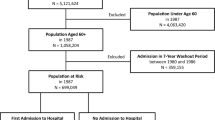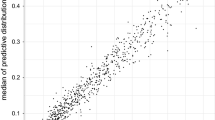Abstract
Objectives
Compression of morbidity postulates that as the populations age, the age of onset of disease is postponed. The objective of this study is to test for evidence of compression of morbidity in Spain.
Methods
We calculated the age and sex-specific incidence of myocardial infarction, heart failure, cerebrovascular disease, as well as bladder, prostate, breast, lung, and colon cancer among hospital discharges covering 99.5 % of the Spanish population, approximately 40 million inhabitants for two non-overlapping periods, 1997–2000 and 2007–2010, and estimated the length of life spent with disease using the Sullivan method.
Results
We found that expansion of morbidity due to an earlier age-specific onset of incident disease and increase in life expectancy was the norm in Spain. Notable exceptions were cardiovascular disease in women (−0.2 % time spent with disease) and lung cancer for men (−0.9 % time spent with disease) from 1997–2000 to 2007–2010.
Conclusions
Compression of morbidity is often cited by policy makers when discussing adjustments to the health-care system. If morbidity is measured by age at onset of disease, the burden of morbidity has increased in Spain.
Similar content being viewed by others
References
Beltran-Sanchez H, Razak F, Subramanian SV (2014) Going beyond the disability-based morbidity definition in the compression of morbidity framework. Glob Health Action 7:24766
Bloom DE, Canning D, Mansfield RK, Moore M (2007) Demographic change, social security systems, and savings. J Monet Econ 54:92–114
Brinks R, Landwehr S, Waldeyer R (2013) Age of onset in chronic diseases: new method and application to dementia in Germany. Popul Health Metr 11(1):1
Carandang R, Seshadri S, Beiser A et al (2006) Trends in incidence, lifetime risk, severity, and 30-day mortality of stroke over the past 50 years. JAMA 296:2939–2946
Chatterji S, Byles J, Cutler D, Seeman T, Verdes E (2015) Health, functioning, and disability in older adults—present status and future implications. Lancet 385(9967):563–575
Ergin A, Muntner P, Sherwin R, He J (2004) Secular trends in cardiovascular disease mortality, incidence, and case fatality rates in adults in the United States. Am J Med 117:219–227
Freedman VA, Agree EM, Martin LG, Cornman J (2006) Trends in the use of assistive technology and personal care for late-life disability, 1992–2001. Gerontol 46:124–127
Freedman VA, Spillman BC, Andreski PM et al (2013) Trends in late-life activity limitations in the United States: an update from five national surveys. Demography 50:661–671
Fries JF (1980) Aging, natural death, and the compression of morbidity. N Engl J Med 303:130–135
Fries JF, Bruce B, Chakravarty E (2011) Compression of morbidity 1980–2011: a focused review of paradigms and progress. J Aging Res 2011:261702
Grau M, Elosua R, Cabrera de León A et al (2011) Factores de riesgo cardiovascular en España en la primera década del siglo xxi: análisis agrupado con datos individuales de 11 estudios de base poblacional, estudio DARIOS. Rev Esp Cardiol 64:295–304
Guerrero F, Santonja F, Villanueva R (2011) Analysing the Spanish smoke-free legislation of 2006: a new method to quantify its impact using a dynamic model. Int J Drug Policy 22:247–251
Gutiérrez-Fisac J, Banegas BJ, Artalejo FR, Regidor E (2000) Increasing prevalence of overweight and obesity among Spanish adults, 1987-1997. Int J Obes Relat Metab Disord J Int Assoc Study Obes 24:1677–1682
Human Mortality Database. University of California, Berkeley (USA), and Max Planck Institute for Demographic Research (Germany) (2013). Available at http://www.mortality.org, http://www.humanmortality.de
Lopez MJ, Nebot M, Schiaffino A et al (2012) Two-year impact of the Spanish smoking law on exposure to secondhand smoke: evidence of the failure of the ‘Spanish model’. Tob Control 21:407–411
Manton KG (1982) Changing concepts of morbidity and mortality in the elderly population. Milbank Mem Fund Q Health Soc 60:183–244
Muggli ME, Lockhart NJ, Ebbert JO, Jimenez-Ruiz CA, Riesco Miranda JA, Hurt RD (2010) Legislating tolerance: Spain’s national public smoking law. Tob Control 19:24–30
Murray CJL, Barber RM, Foreman KJ, et al (2015) Global, regional, and national disability-adjusted life years (DALYs) for 306 diseases and injuries and healthy life expectancy (HALE) for 188 countries, 1990–2013: quantifying the epidemiological transition. Lancet 386(10009):2145–2191
Parikh NI, Gona P, Larson MG et al (2009) Long-term trends in myocardial infarction incidence and case fatality in the National Heart, Lung, and Blood Institute’s Framingham Heart study. Circulation 119:1203–1210
Peiro S, Librero J (1999) The quality assessment from the minimum basic hospital discharge data set. Rev Neurol 29:651–661
Rivero-Cuadrado A (2001) El conjunto mínimo básico de datos en el SNS: inicios y desarrollo actual. Rev Fuentes Estadísticas 49:18–19
Romeu Gordo L (2011) Compression of morbidity and the labour supply of older people. Appl Econ 43:503–513
Sullivan DF (1971) A single index of mortality and morbidity. HSMHA Health Rep 86:347–354
Verbrugge LM, Jette AM (1994) The disablement process. Soc Sci Med 38:1–14
Vos T, Barber RM, Bell B et al (2015) Global, regional, and national incidence, prevalence, and years lived with disability for 301 acute and chronic diseases and injuries in 188 countries, 1990–2013: a systematic analysis for the Global Burden of Disease Study 2013. Lancet 386:743–800
Author information
Authors and Affiliations
Corresponding author
Electronic supplementary material
Below is the link to the electronic supplementary material.
Rights and permissions
About this article
Cite this article
Walter, S., Beltrán-Sánchez, H., Regidor, E. et al. No evidence of morbidity compression in Spain: a time series study based on national hospitalization records. Int J Public Health 61, 729–738 (2016). https://doi.org/10.1007/s00038-016-0829-5
Received:
Revised:
Accepted:
Published:
Issue Date:
DOI: https://doi.org/10.1007/s00038-016-0829-5








